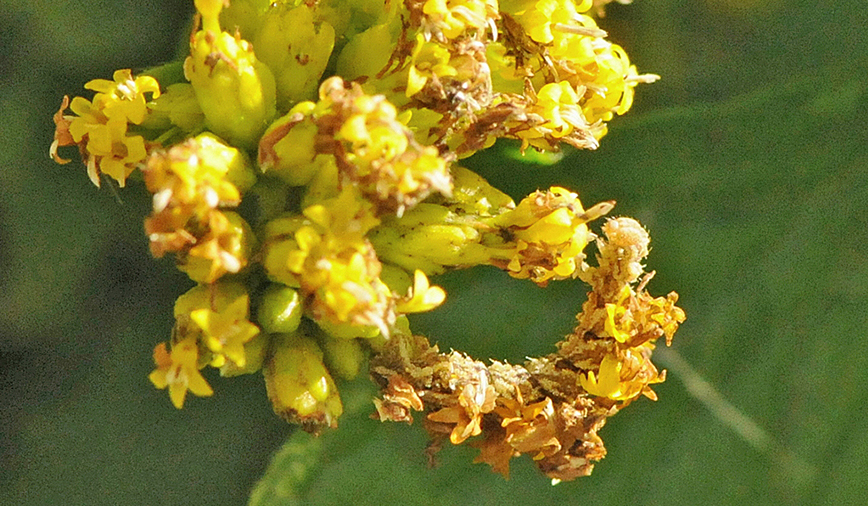Do you remember when you first were allowed to dress yourself?
Oh the freedom! The thrill! The independence to wear your favorite stripes, plaids and floral patterns, individually or all at once. It didn’t really matter whether the articles matched; the main thing was that you’d picked them out and put them on all by yourself.
These days though, perhaps you, like me, have found this daily chore has become a little tiresome. Instead of excitement and adventure, your dresser and closet, like mine, present one bewildering question after another. Does this blouse match this skirt? When was the last time I wore that shirt? Can these pants pass for clean?
Friends, if you too have fallen victim to the dressing doldrums, read on. I’ve recently found renewed enthusiasm for self-adornment, and maybe you can too. It’s all thanks to our good neighbor, Synchlora aerata.
Also known as the camouflaged looper, this caterpillar falls into the category of Fairly Common But Rarely Seen, thanks to its ability to “dress itself” using fragments of petals from its host plants. That right folks, this little larva picks out pieces of plants and adheres them to its back using sticky silk. It’s not just a one-and-done effort, either. Because the bits tend to wither and wilt rather quickly, the caterpillar has to “change clothes” frequently—or else risk getting eaten. Talk about a great motivator!
The camo looper is a member of the moth family Geometridae, a large group with more than 35,000 species worldwide and about 1,400 species in North America. The name is derived from the Latin geometra, or earth measurer, a term that refers to the caterpillar’s peculiar way of moving around. Looping up, then stretching out, these guys inch along on leaves and branches, earning their other common name, inchworm, every step of the way.
(Fun fact: Inchworms aren’t just showing off. Other types of caterpillars, which move with more of a shuffling motion, do so because they have five sets of prolegs—fleshy appendages that protrude from their abdominal segments. Five pairs of prolegs mean these caterpillars have lots of gripping power, which permits the larva to move forward in a rippling wave of motion. Inchworms, a.k.a. loopers, in contrast, have only two pairs of prolegs, located at the rear of the body. They must draw their hindquarters up toward the head, then reach forward in order to “inch” along.)
Cool locomotion aside, looper caterpillars also are hairless, which means they’re ideal prey for many types of insectivores. While some loopers rely on color or posture for defense, the camo looper is the only species in our area that goes that extra mile and attaches plant bits to enhance its disguise.
The species isn’t particularly fussy about host plants, and can be found on many species of asters, black-eyed susans, blazing stars, boneset, goldenrods, raspberries, roses and St. John’s worts. Camo loopers will even venture into non-native territory and conceal themselves on chrysanthemums, daisies, yarrow and Queen Anne’s lace—which is where Good Natured readers Alice DuBois and Tim Campbell found their looper a couple of weeks ago.
“I noticed a little worm that looked identical to the white flower part of the plant, inching up and down,” Alice said in an email. At first perplexed, she did some research and discovered the amazing dress-up talents of Synchlora aerata.
Provided its camouflage is effective, the little looper will grow to a length of a little over half an inch, before pupating and emerging with a completely different look—and name: the wavy-lined emerald moth. These small (wingspan less than 1 in.) moths often appear at porch lights on warm evenings and can be identified by their pastel green wings with undulating (“wavy”) lines.
The next time you’re faced with a clothing conundrum, remember the lessons learned from our friend the camo looper. Pick pieces that go together, add a touch of silk and keep them fresh.
Most important, dress for success and always remember: If you don’t get eaten, you know you’re doing it right.
Pam Otto is the manager of nature programs and interpretive services at the Hickory Knolls Discovery Center, a facility of the St. Charles Park District. She can be reached at 630-513-4346 or potto@stcparks.org.

